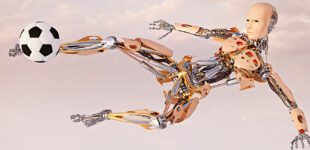October 24, 2024
The world is built for humans. Robots? Not so much. Most robots don’t move like humans. As a result, they struggle to operate in the real world. Think, for example, of the robots you may have seen. There are robotic vacuum cleaners shaped like small disks roaming around the home, getting snagged on dining room table chairs and other obstacles.
Then there are the robotic arms on assembly lines, designed to do the same repetitive task from a single location over and over. Far from being able to operate independently in a world built for humans, these robots require the environment they work in to be tailored to their capabilities.
This is why companies around the globe are investing billions in the development of humanoid robots that have two legs and two arms and look and move like humans. Humanoid robots are more flexible and adaptable to varied conditions. In theory, a company could build one model robot, and the user could train it to do a specific task: no special environment needed. According to a 2024 report, the global market for humanoid robots may reach $35 billion by 2035, up from about $100 million in 2023.
In “The Impact of Technology in 2025 and Beyond: an IEEE Global Study,” a recent survey of technology leaders, 37% of respondents said they are considering implementing humanoid robots into operations in 2025, while 35% expect to have an implementation of humanoid robots started and 18% expect to have them fully implemented into operations.
Faster, Lighter, Less Expensive
Driving the advance of humanoid robotics is a significant improvement in all of the components that go into them, from software to parts. The parts are more cost-effective, lighter and small enough to be integrated into a commercial product. This includes the arms and legs, perception and motion sensors and the onboard computing.
Increasingly, the robots are all-electric, rather than a mix of electric and hydraulic, which also makes them lighter.
The overall weight of components is essential. Moving heavy components requires more energy, which requires either heavier batteries or more frequent battery charging.
“Earlier robots required frequent recharges or tethered power sources. Modern battery packs offer longer duration without compromising mobility,” said IEEE Senior Member Santhosh Sivasubramini. “This development allows robots to operate longer. Today’s humanoids also feature lighter and more compact batteries. This leads to better weight distribution and improved energy management.”
Seeing Is Achieving
Older robots tended to rely on basic vision and force sensors to both navigate the environment and determine how much pressure to use to pick something up.
“Modern robots use LIDAR, stereo cameras and force-torque sensors. These enable better environment mapping, obstacle detection and object handling,” Sivasubramini added. “Advanced sensor fusion algorithms process multiple inputs in real-time. This supports quicker response and adaptation in changing scenarios.”
What We See on Video
If you’ve seen videos of humanoid robots performing parkour maneuvers and navigating complex terrain like athletes, you might want to question whether those videos reflect the robot’s actual operating environment. Frequently, these videos are produced in highly controlled environments that don’t reflect real-world conditions. Yes, the robots did perform what you saw on video, but it may have taken multiple attempts, and slight differences in the terrain would make it difficult to replicate those feats.
Today’s humanoid robots are still in the development stage. Even getting them to do simple tasks requires significant amounts of training. While artificial intelligence is making this training faster, robots perform best in controlled environments where the tasks they are assigned are extremely repetitive.
“While the videos may reflect genuine technological advancements, they don’t always represent how these robots will perform in everyday situations,” said IEEE Graduate Student Member Shally Gupta.
What Will Robots Do?
Robots remain, for now at least, limited in their capabilities. Because of these limitations, most robot tasks will be limited to things humans don’t want to do: repetitive, boring or dangerous.
One of the largest barriers to using robotics is cost. Humanoid robots are frequently deployed in warehouse applications because the environment is fairly predictable, and the work is repetitive. But purchasing robots is only the beginning of the cost structure of using them. Warehouse operators deploying robotics might need to hire specialized personnel to train and maintain the robots. Training might also require significant time and investment.
A more likely scenario is that humans and robots will work side-by-side.
“Humanoid robots need to work safely and smoothly alongside humans,” Gupta said. “They have to deal with unexpected situations and interact with people naturally. Getting this right takes a lot of research and testing, so it can be tough to make humanoid robots practical and affordable enough for everyone to use.”
Learn More: The IEEE Robotics and Automation Society has a robust technical committee dedicated to solving the challenges of humanoid robotics. Check it out.
Check out this comprehensive guide to humanoid and other robots on IEEE Spectrum





 Meaningful Momentum or Running in Place?
Meaningful Momentum or Running in Place? AI Through Our Ages
AI Through Our Ages Liquid Infrastructure: Our Planet's Most Precious Resource
Liquid Infrastructure: Our Planet's Most Precious Resource The Impact of Technology in 2025
The Impact of Technology in 2025 Quantum and AI: Safeguards or Threats to Cybersecurity?
Quantum and AI: Safeguards or Threats to Cybersecurity? Why AI Can't Live Without Us
Why AI Can't Live Without Us Bits, Bytes, Buildings and Bridges: Digital-Driven Infrastructure
Bits, Bytes, Buildings and Bridges: Digital-Driven Infrastructure Impact of Technology in 2024
Impact of Technology in 2024 Emerging AI Cybersecurity Challenges and Solutions
Emerging AI Cybersecurity Challenges and Solutions The Skies are Unlimited
The Skies are Unlimited Smart Cities 2030: How Tech is Reshaping Urbanscapes
Smart Cities 2030: How Tech is Reshaping Urbanscapes Impact of Technology 2023
Impact of Technology 2023 Cybersecurity for Life-Changing Innovations
Cybersecurity for Life-Changing Innovations Smarter Wearables Healthier Life
Smarter Wearables Healthier Life Infrastructure In Motion
Infrastructure In Motion The Impact of Tech in 2022 and Beyond
The Impact of Tech in 2022 and Beyond Cybersecurity, Technology and Protecting Our World
Cybersecurity, Technology and Protecting Our World How Technology Helps us Understand Our Health and Wellness
How Technology Helps us Understand Our Health and Wellness The Resilience of Humanity
The Resilience of Humanity Harnessing and Sustaining our Natural Resources
Harnessing and Sustaining our Natural Resources Creating Healthy Spaces Through Technology
Creating Healthy Spaces Through Technology Exceptional Infrastructure Challenges, Technology and Humanity
Exceptional Infrastructure Challenges, Technology and Humanity The Global Impact of IEEE's 802 Standards
The Global Impact of IEEE's 802 Standards Scenes of our Cyber Lives: The Security Threats and Technology Solutions Protecting Us
Scenes of our Cyber Lives: The Security Threats and Technology Solutions Protecting Us How Millennial Parents are Embracing Health and Wellness Technologies for Their Generation Alpha Kids
How Millennial Parents are Embracing Health and Wellness Technologies for Their Generation Alpha Kids Space Exploration, Technology and Our Lives
Space Exploration, Technology and Our Lives Global Innovation and the Environment
Global Innovation and the Environment How Technology, Privacy and Security are Changing Each Other (And Us)
How Technology, Privacy and Security are Changing Each Other (And Us) Find us in booth 31506, LVCC South Hall 3 and experience the Technology Moon Walk
Find us in booth 31506, LVCC South Hall 3 and experience the Technology Moon Walk Virtual and Mixed Reality
Virtual and Mixed Reality How Robots are Improving our Health
How Robots are Improving our Health IEEE Experts and the Robots They are Teaching
IEEE Experts and the Robots They are Teaching See how millennial parents around the world see AI impacting the lives of their tech-infused offspring
See how millennial parents around the world see AI impacting the lives of their tech-infused offspring Take the journey from farm to table and learn how IoT will help us reach the rising demand for food production
Take the journey from farm to table and learn how IoT will help us reach the rising demand for food production Watch technical experts discuss the latest cyber threats
Watch technical experts discuss the latest cyber threats Explore how researchers, teachers, explorers, healthcare and medical professionals use immersive technologies
Explore how researchers, teachers, explorers, healthcare and medical professionals use immersive technologies Follow the timeline to see how Generation AI will be impacted by technology
Follow the timeline to see how Generation AI will be impacted by technology Learn how your IoT data can be used by experiencing a day in a connected life
Learn how your IoT data can be used by experiencing a day in a connected life Listen to technical experts discuss the biggest security threats today
Listen to technical experts discuss the biggest security threats today See how tech has influenced and evolved with the Games
See how tech has influenced and evolved with the Games Enter our virtual home to explore the IoT (Internet of Things) technologies
Enter our virtual home to explore the IoT (Internet of Things) technologies Explore an interactive map showcasing exciting innovations in robotics
Explore an interactive map showcasing exciting innovations in robotics Interactively explore A.I. in recent Hollywood movies
Interactively explore A.I. in recent Hollywood movies Get immersed in technologies that will improve patients' lives
Get immersed in technologies that will improve patients' lives